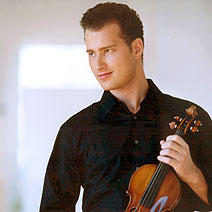This review is an Ionarts exclusive.
 Youthful earnestness and energy were in abundance for the latest concert in the Friends of Music series at Dumbarton Oaks. The members of the Prima Trio, heard on Monday evening, are in different stages of graduate school and early professional careers. A win at the 2007 Fischoff Chamber Music Competition, where they received the Grand Prize and Gold Medal, has launched them into a fairly intense schedule of performing. As a chamber ensemble they have chosen difficult terrain: the combination of violin (David Bogorad), clarinet (Boris Allakhverdyan), and piano (Anastasia Dedik) -- even with the violinist also playing viola as an alternative -- has at best a limited repertoire. The Verdehr Trio, who still teach at my alma mater, Michigan State University, have played it all so many times that they have commissioned a couple hundred new pieces just to keep things interesting.
Youthful earnestness and energy were in abundance for the latest concert in the Friends of Music series at Dumbarton Oaks. The members of the Prima Trio, heard on Monday evening, are in different stages of graduate school and early professional careers. A win at the 2007 Fischoff Chamber Music Competition, where they received the Grand Prize and Gold Medal, has launched them into a fairly intense schedule of performing. As a chamber ensemble they have chosen difficult terrain: the combination of violin (David Bogorad), clarinet (Boris Allakhverdyan), and piano (Anastasia Dedik) -- even with the violinist also playing viola as an alternative -- has at best a limited repertoire. The Verdehr Trio, who still teach at my alma mater, Michigan State University, have played it all so many times that they have commissioned a couple hundred new pieces just to keep things interesting.
The main appeal of a concert by this type of ensemble is the chance to hear music that does not get played all that often. Frankly, some of the composers who were announced for this concert were of greater interest than what ended up on the program. So there was no Lotti, Schumann, or Ives, and saddest of all, no Milhaud Suite (you can listen to some sound clips on the group's Web site), but what the group did play was performed with verve and a balanced sense of ensemble. The "Kegelstatt" trio (E-flat major, K. 498) had an amiable, playful sound that recalled the piece's origins, music intended for the composer to play with his friends at the regular parties held in the home of Gottfried von Jacquin. Khachaturian's Trio for Clarinet, Violin, and Piano had a sultry first movement with echoes of Rimsky-Korsakov's Scheherazade, but a tasteful performance was not enough to make this work anything more than the folksy and repetitive pablum it is.
More memorable were the selections from Max Bruch's Eight Pieces for Clarinet, Viola, and Piano, op. 83, and Stravinsky's arrangement for clarinet, violin, and piano of his music for L'Histoire du Soldat. The Bruch is a major work, with equal roles for the viola and clarinet, as well as a demanding part for the pianist: this was a good performance, but with just enough problems of intonation and slight blemishes in the piano to keep it from being a great one. It had a much more interesting use of folk elements, in the gypsy-influenced fifth movement, and a joky, Mendelssohnian romp in the seventh. The Prima Trio gave the Stravinsky a plucky first movement, striking a solid tempo risoluto, with a style that was more bubbly than biting until the concluding Devil's Dance. The program would have been stronger without the Khachaturian (as well as largely unnecessary narration from Bogorad) and a full performance of either the Bruch or Stravinsky (or both) instead. Desserts included a final selection of Peter Schickele's Serenade for Three, an indulgence in Stravinsky-esque rhythmic drive, an obsession with melodic patterns reminiscent of Philip Glass, Copland-like misty harmony, and glib references to American popular music, as well as a substantial encore, the Autumn part of Astor Piazzola's Four Seasons of Buenos Aires.
The final concert on the Friends of Music series at Dumbarton Oaks will feature violinist David Grimal and pianist Georges Pludermacher (April 15 and 16), in a program of composers from eastern Europe.































































